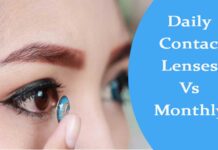Sometimes in life, products like one-size-fits-all are ideal! It alleviates the burden of finding the perfect fit, and it is often fast, simple, and convenient. However, one-size-fits-all is inconvenient and possibly harmful in terms of contact lenses since it may lead to severe eye and vision problems.
Because contact lenses place themselves directly on people’s cornea, the dimensions of contact lenses must be 100% precise to guarantee a pleasant, healthy fit. This can help avoid eye infections, pain, and other eye problems, including corneal abrasion, a painful scrape on the eye surface that may make blinking unpleasant.
This article will cover the topic of what is contact lens fitting and also other relevant issues.
What is a Contact Lens Fitting?
A contact lens fitting is a procedure in which people are checked to verify that the contact lenses they use fit correctly and have the correct prescription.
During your visit, you won’t only be shown how to insert your lenses, but also you will be given a few short tests to ensure that your site is properly. It is to help you not feel dizzy after wearing new lenses.
During an eye test, it may be difficult to determine the precise prescription strength as necessary. Getting a lens fitted for contact will also help us ensure that we did a good job and saw correctly.
Do I need a Contact Lens Fitting?
For a doctor, contact lens fittings aim to ensure that these fit the patient’s eyes correctly. For the first-timers, the doctor will take measurements and take his time to show you the proper way to use your contacts.
The brands of different contact lenses people use are part of their prescription; various brands use various materials, etc. Because certain lenses function better on specific eye types than others, having a doctor suggest new contacts is critical.
There could be many reasons for changing your contact lenses. Like:
A Changed Prescription
In this scenario, you might need to upgrade the powered contact lens. Prescriptions for contact lenses are not similar to the prescriptions for spectacles.
A More Fitting Contact Lens
The curvature of a cornea gets measured by using a device known as a keratometer. Apart from it, doctors sometimes use a topographer to map out the whole cornea.
The curvature of the cornea determines the lens size. Typically, eye specialists prefer to evaluate whether the lens fit after a few hours it gets worn out.
An Aligned Lens
Contacts are replaced on a daily, biweekly, weekly, monthly, and yearly basis. Based on your predisposition and eye health, you must choose the healthiest, most flexible, and most cost-effective option.
A Safer Contact Lens
Some individuals may benefit from frequent lens changes if they have allergies or dry eyes. Patients with dystrophies, corneal scars, or uneven surfaces might need a specialized lens to get fitted.
Patients should go through the various choices during their contact lens examination. You should even venture ideas you hadn’t considered.
Like patients who use wear bifocals or cheaters. Maybe you have been regularly using cheaters for your whole life and didn’t know there were multifocal lens alternatives.
Steps of Contact Lens Fitting

Content lens fitting can be done in many ways. Some processes are completely free, whereas some tests require money. In most cases, the payment will depend on the facility from where you are getting lens fitting or the procedure.
Here are the most common steps that you have to go through while getting a free contact fitting.
A Thorough Eye Exam
To begin, an eye doctor will conduct an examination similar to a standard eye health check. This is conveyed to ensure that you haven’t got a pre-existing health problem that might interfere with pleasant and safe contact lens use.
Your optometrist here will perform a slit lamp test to examine your eyes’ inner tissues thoroughly.
Because contact lenses need an immediate vision prescription, vision testing is an important component of this checkup. Once your eyesight and ocular health have been confirmed to be appropriate for contact lenses, the following step is a precise contact lens fitting.
A Thorough Consultation
Because there are many different kinds of lenses on today’s market, your doctor will need to know about your activities and lifestyle in order to decide which lenses will be best for you.
Things to consider:
- Do you prefer daily disposable lenses or contacts that may be used for longer periods of time?
- Did you wish to alter the color of your eyes?
- Do you want gas-permeable glasses that are rigid or soft? Inquire with your optometrist about the advantages and disadvantages of each kind.
- Do you intend to use your contact lenses on a regular basis or just for special events and activities?
Contact Lens Fitting
Various technologies may be utilized during your lens fitting depending on the eyes. An incorrect contact lens fit may cause discomfort or injury to your eye. That is why it is critical to get a precise and thorough fitting.
A variety of measures are important in establishing a prescription, including:
Corneal Curvature
In most cases, eye doctors utilize keratometers to evaluate the curvature of a cornea, which is on the front side of the eyes and where contacts lenses rest. These figures aid in determining the base curve and lens diameter that show on the lens prescription.
Iris and Pupil Size
These measurements may be taken using either a slit light or a hand-held ruler. Your iris and pupil sizes are important factors in determining the optimal lens design. Such information is especially essential if you’re looking at hard gas-accessible contact lenses.
Lens Prescription
also, The following data is usually included in a full lens prescription:
OD & OS: These letters stand for the right eye and left eye respectively, and are derived from Latin words.
PWR: It stands for refractive power. It could be the amount of correction required to achieve 20/20 vision. This number is expressed in diopters. Only if it begins with a negative sign, a patient is nearsighted, and on the contrary, if it begins with a plus sign, the patient farsighted. Each eye often gets a distinct power.
BC: It stands for Base Curve, which defines the rear curvature of the lens. The number corresponds to the curvature of your cornea. A few lens manufacturers only provide one basic curve.
CYL: Cylinder value, which ranges from negative 4 to positive 4, is the amount of force needed to correct your astigmatism.
Axis: The axis specifies the cylinder orientation value on the lens in degrees.
Conclusion
This is a contact lens tutorial with a particular use in mind. Its goal is to teach the reader about the significance of proper contact lens fitting. It is critical for patients’ well-being to learn about the various contact lens materials, new technologies, lens kinds, and fitting methods. Hope you got what is a contact lens fitting.






